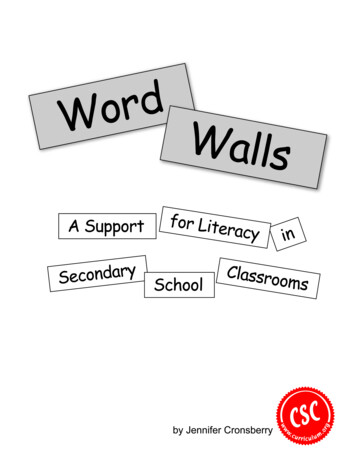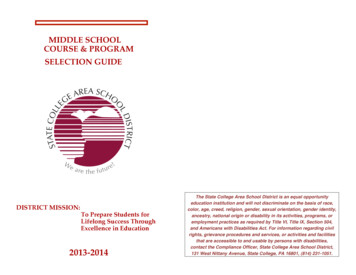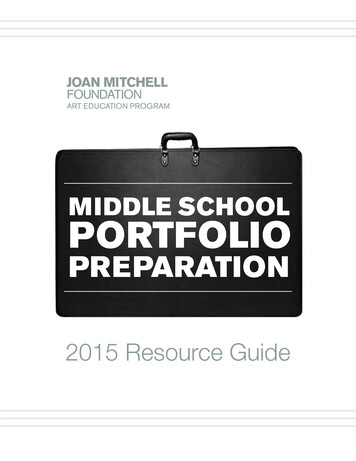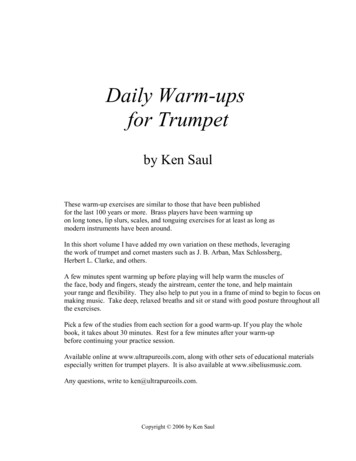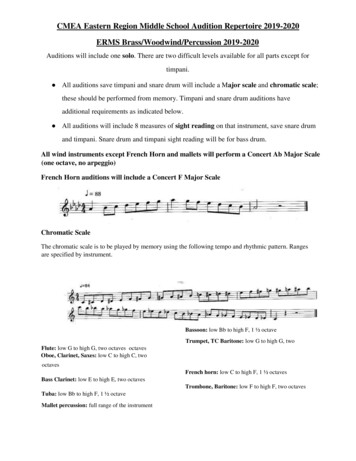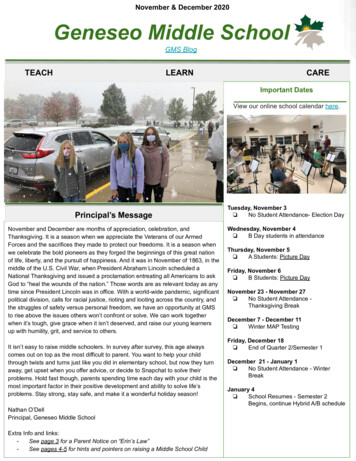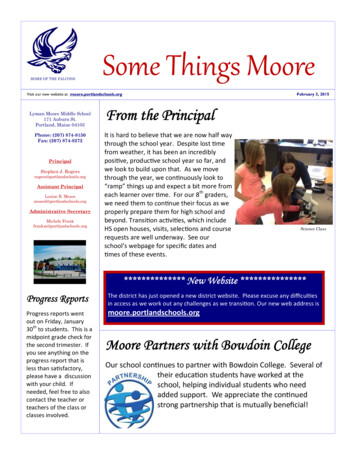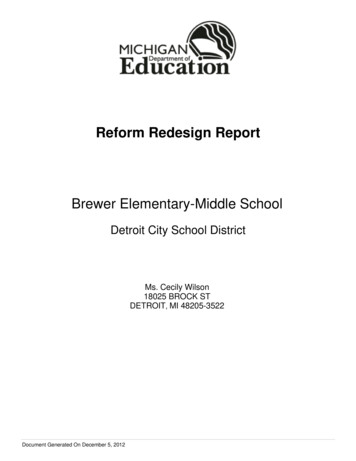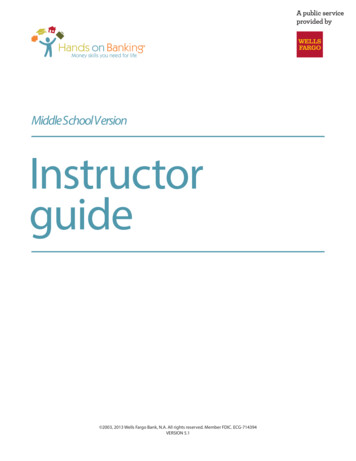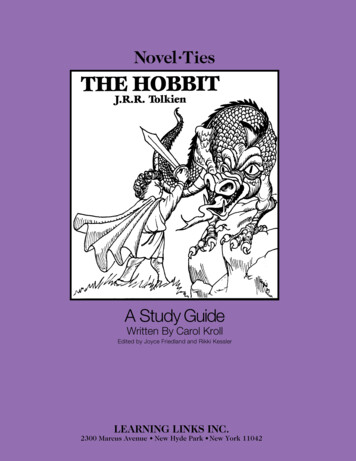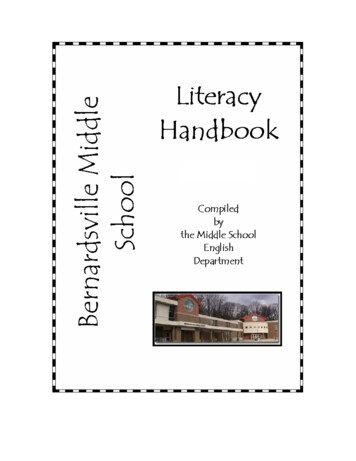
Transcription
The Bernardsville Middle SchoolLiteracy HandbookPrepared by English DepartmentBernardsville Middle School2001Revised 2004 by Ann Smith and Markie BurkeDr. Lynn Kratz, principalRevised 2006 to include portions of the BMSResearch Manual by Kathy GeorgeRevised 2007 to add Speaking RubricCopyright, 2001Bernardsville Middle SchoolSomerset Hills School DistrictBernardsville, New Jersey 07924ii
Table of ContentsWritingWriting Process .1-7The Paragraph .8-12The Essay .13-16Traits of a Well Written Paper .17-18The Middle School Writing Rubric . 19Revision Techniques .20-21Editing Marks .22-24Transitional Expressions .25-26Standards of Formal English .27-28Style Sheet.29-32Final Copy Formats .33-34The Eight Parts of Speech .35-37The Parts of the Sentence . 38Capitalization.39-40Punctuation .41-44Spelling Demons and Troublesome Words.45-48Grammar and Usage Scope and Sequence .49-50ReadingReading Skills Scope and Sequence . 51Literary Terms .52-54Reading and Writing in All Subject AreasReading Response Journals .55-57Business Letter .58-59Science Lab Format . 60Exemplars and Rubrics .61-67Research.68-75Speaking and Listening in All Subject AreasClass Discussion . 76Small Group Activities . 76Oral Presentations and Speeches.77-81Speaking Rubric. 82iii
NOTESiv
The Writing ProcessWriting is a skill that follows five specific steps. The five main steps in thewriting process are pre-writing, drafting, revising, editing, and publishing.I. PRE-WRITINGThis is the planning stage for a piece of writing and the first step inthe writing experience. During this step, writers explore and select topics,unless the topic is teacher selected. Even during this initial step, writersmust identify the task, the audience for whom they will be writing, and thepurpose for writing. These terms may be defined as follows:1. task—What am I being asked to write?2. audience—Who will read/hear my piece?3. purpose—What do I hope to accomplish by writing?Pre-writing involves gathering and organizing ideas about a topic and mayinclude the nstormingDiscussingReading of modelsInformation gathering (library, research, ting with audio visualsOtherMODEL: BrainstormingBrainstorming is defined as generating a group of thoughts orideas on a particular subject that may be used in a piece of writing.1
BRAINSTORMING ABOUT MR. CUNNINGHAM:coachfriendmath teacherencourages usanswers our questionsalways friendlytells funny jokeswe learn a lotgives good advicemakes learning funMODEL: WebbingAfter brainstorming a list, writers arrange thoughts and ideas in anattempt to organize the information generated.answers our questionsWEBBING ABOUT MR. CUNNINGHAM:we learn a lotencourages usmakes learning funhelpfulmath teachercoachMR. CUNNINGHAMfriendalways friendlygives good advicetells funny jokesII. DRAFTINGDrafting is the second step in the writing process. In the draftingstep, writers put their ideas into sentences. Then they build their sentencesinto paragraphs. The primary focus in drafting is merely to get ideas downon paper. Writers should not worry about mistakes in this step. Mistakescan be fixed later during revision. Depending upon the age and experienceof the writer and the difficulty/complexity of the writing assignment, one ormore drafts may be necessary. During drafting, writers should skip lineswhen producing either a word-processed copy or a hand written copy oftheir pieces, as this will make the revision step much easier.2
MODEL: DRAFTINGA Great TeacherFunny, helpful, and friendly—who am I describing? Is it oneof your classmates or your best friend? Believe it or knot, I’m describinga teacher! His name is Mr. Cunningham, and we call him Mr. C. for short.One thing I really like about him is the way he always makes learning fun.We have some boring topics to get through in our math book, butMr. Cunningham makes even boring topics fun by saying something thatis so funny that we all want to learn. Once I sneezed really loud rightin the middle of class. Just then Mr. Cunningham said “googolplex.”It sounded a lot like a gesundheit or bless you, so everyone had a goodlaugh, including Mr. Cunningham.3
III. REVISING AND SHARINGRevising is the third step in the writing process. During this step,writers see (vision) the piece again (re-) in their mind’s eye and begin tomake necessary improvements. It is important to understand that thoroughand effective revision can make the difference between a mediocre piece ofwriting and a truly excellent piece of writing.During revision, writers look for words and phrases that need to bechanged. They may decide to add more information or remove someinformation. They may choose to arrange their ideas in a different way.Changes in a draft should address the five items on the Middle SchoolWriting Rubric (Content, Organization, Sentence Fluency, Voice/Impact,and Conventions). Please refer to the section of this handbook labeledTraits of a Well Written Paper (page 17) for more information.So that errors may be corrected and improvements made, writersshould ask themselves, or a partner, these questions during the revisionprocess:1. Does my piece have a distinct focus?2. Does my piece use strong, interesting, relevant details?3. Is my writing easy to follow with an effective beginning, middle,and ending?4. Have I written an especially effective beginning? Because it setsthe tone for the piece, the opening paragraph, sentence, line,phrase, word, or title is the most important part of the work.5. Does my piece move smoothly along from one section to the next(use of transitions)?6. Have I used the correct format?7. Have I used a variety and complexity of words, sentence lengths,and sentence beginnings/endings? Nouns and verbs should beespecially well chosen. Avoid excessive use of adjectives andadverbs.8. Has my piece eliminated run-ons and fragments?9. Is my piece interesting? Readers are not interested in abstractphilosophies. They want to be entertained and instructed.ADVICE about revision: Revise, revise, revise. It is almostimpossible to get it right on the first try.4
5
IV. EDITINGEditing is the fourth step in the writing process. During this step,writers proofread their drafts in preparation for producing a final copy by:1. Checking to make sure they have fulfilled the requirements of theassignment. Remember to once again ask yourself questions aboutTAP - task, audience, purpose of your piece2. Correcting mechanical errors such as grammar, spelling,punctuation, capitalization, usage3. Correcting typographical errors4. Checking format and designMODEL: FINAL COPYA Great TeacherWho is funny, helpful, and friendly? Is it one of my classmatesor my best friend? Believe it or not, I am describing my favoriteteacher! His name is Mr. Cunningham, and we call him Mr. C. forshort. One of his best qualities is the way he always makes learningfun. We have some boring topics to get through in our math book, butMr. Cunningham makes even uninteresting topics fun by saying ordoing something so funny that we want to learn. Once I sneezed reallyloudly right in the middle of geometry class. Just then Mr. Cunninghamsaid “googolplex.” It sounded a lot like “gesundheit” or “bless you,” soeveryone had a good laugh, especially Mr. Cunningham.6
PUBLISHINGThis is the fifth step in the writing process. In this step, writers sharetheir final copies with an audience. This may be accomplished in a numberof different ways.1. Having the final copy read silently by an individual and/or group2. Having the final copy read orally to the teacher, classmate, otherselected person or group3. Displaying the work on classroom bulletin boards, hall bulletinboards, or in the office of administrators4. Having the work published in school or town publications5. Sending the work to other interested parties, companies, contests,newspapers, or literary magazines6. Publishing pieces of writing in bound book form to be shared byother students in the school and community7. Organizing a classroom or school read-a-thon day so that writerscan share their pieces/books in person with peers or students inyounger grades within the school system8. Publishing on a websiteModels for brainstorming, webbing, drafting, revision/editing and final copy wereadapted from Writers Express, Great Source Education Group, a Houghton MifflinCompany, 2000, page 76.7
THE PARAGRAPHA paragraph may be defined as a group of three or more relatedsentences that explain or develop a single idea. The four main reasons forwriting paragraphs are to describe, to tell a story, to explain, or topersuade. In a well written paragraph, the main idea is expressed clearly ina topic sentence. Then each sentence in the body of the paragraph workstogether logically to support the idea/s expressed in the topic sentence.Sentences that give more information about the topic sentence are calledsupporting details. Some paragraphs also use transitional words, whichare words that connect one idea or sentence to another. The concludingsentence, sometimes called the clincher, is a sentence that ties the paragraphtogether by restating the main idea of the paragraph.MODES OF WRITINGDescription - describes someone or something or some placeNarration - tells a story with characters and plotExposition - provides information and explainsPersuasion - influences the readerSelf-expression - focuses on the writer’s feelingsPARAGRAPH WORKSHEET—The following model of a paragraphworksheet is taken from Middle School Writing Handbook, LivingstonSchool District, 1994 edition.8
9
10
MODEL: FINAL PARAGRAPHTrees may be the most important form of plant life on earth. Treesadd beauty to the landscape and give shelter to wildlife. In addition, treeroots prevent soil erosion and help store water. Different types of treesprovide wood, paper, food, medicines, and other useful products. Though itis something invisible, one of the most important things trees do is helpclean the air. Trees absorb carbon dioxide and produce oxygen. It is oxygenthat people need to breathe. People can thank trees for a lot more thanshade.(from Writers Express)REVIEW OF PARAGRAPH VOCABULARY1. Paragraph—a group of sentences that are placed together and relate tothe same topic or idea. This topic is called the main idea. It tells whatthe paragraph is about. All of the sentences in a paragraph must relate tothe main idea. The first line of a paragraph is often indented. It is movedover from the left margin five spaces to the right. Some paragraphs arenot indented. They are separated by blank white spaces.2. Topic sentence—lets the reader know what the paragraph will be about.It is usually the first sentence of the paragraph. The main idea of aparagraph is usually stated in the topic sentence. All other sentences inthe paragraph should support the topic sentence.3. Supporting details—in addition to a topic sentence, all paragraphs musthave a body. The body is the main part of the paragraph. It includessentences that relate to the main idea. The sentences in the body arecalled supporting details. They give more information about the topicsentence.4. Concluding sentence (clincher)—many paragraphs end with aconcluding sentence. It tells the reader that the paragraph is ending. Theconcluding sentence usually does not add new information. It restates themain idea of the paragraph.5. Transitional words—these words connect one idea or sentence toanother. They also help the sentences to flow more smoothly and assistin organizing the information presented. For more information abouttransitional words, refer to the separate section of this handbook labeledTransitional Expressions, pages 25-26.11
Paragraph Checklist1. Is your paragraph composed of three or more sentences which relate tothe same idea?2. Have you written an effective topic sentence which clearly states themain idea of the paragraph?3. Have you remembered to include enough supporting details which givemore information about your topic sentence?4. Have you written an effective concluding sentence or clincher whichrestates the main idea of your paragraph?5. Have you used transitional words when necessary to connect one idea orsentence to another?6. When you or a classmate reads your paragraph, will you/he have an easytime stating the main idea for what you have written?7. When you or a classmate reads your paragraph, will you/he have an easytime stating supporting details for what you have written?8. Have you remembered to indent your paragraph?NOTE: If the answer to any of these questions is NO, your paragraph needsfurther revision and editing.SOURCESWorld of Language, Silver Burdett Ginn, 1996.Language Arts Today, McGraw Hill School Division, 1998.Basic English Third Edition, Globe Fearon Educational Publisher, 2000.Language Handbook Level E, Steck-Vaughn Company, 1999.Writers Express, Great Source Education Group a Houghton Mifflin Company, 2000.Middle School Writing Handbook, Livingston School District, revised 1994.Writing From The Inside Out: Revising For Quality, by Vicki Spandel and Ruth Culham,Northwest Regional Educational Laboratory, 1995.12
THE ESSAYAn essay or composition is a piece of writing comprised of severalparagraphs. It has three parts: an introduction, a body, and a conclusion.The introduction is the beginning of the essay; it presents the topic.The introduction states the essay’s main idea in a focused thesis statement,and it captures the reader’s interest.The body comes after the introduction and usually consists of at leastthree paragraphs. Each paragraph contains a clear topic sentence along withspecific supporting details and examples.The conclusion is the last part of the composition and brings it to aclose by restating the main idea that was given in the thesis statement or bysumming up the body paragraphs.Structural OverviewIntroduction(Thesis statement)Body Paragraphs(Topic sentencesthat relate to thethesis, alongwith supportingdetails)Conclusion(Thesis statement restated)To have unity, the paragraphs in the body should all support the thesisstatement with details, facts, and related information. For coherence, ideasshould be organized logically and should be connected by transitions. Seelist of transitions on pages 25-26.13
Outline for Five Paragraph EssayTitle (Do not underline or put in quotation marks.)IntroductionThesis statement:First body paragraphTopic sentence:Supporting detail 1:Supporting detail 2:Supporting detail 3:Second body paragraphTopic sentence:Supporting detail 1:14
Supporting detail 2:Supporting detail 3:Third body paragraphTopic sentence:Supporting detail 1:Supporting detail 2:Supporting detail 3:Conclusion - restatement of thesis:15
Essay ChecklistThis checklist may be used for self-evaluation and peer evaluation.Writer1. Is the essay distinctly focused on the topic?Reader2. Is an effective introduction evident?3. Is an effective closing evident?4. Is the essay divided into well-constructed paragraphs?5. Are key ideas stated in explicit, unified topic sentences?6. Are key ideas supported by appropriate and varied details?7. Is there a logical progression of ideas?8. Do effective transitions provide a sense of unity?9. Is sentence construction complete and correct?10. Are sentences varied in length and structure?11. Is there effective word choice?12. Is there correct verb tense formation?13. Is subject-verb agreement evident?14. Is there correct pronoun usage and agreement?15. Is writing free from spelling errors?16. Is writing free from capitalization errors?17. Is writing free from punctuation errors?18. Does the essay sustain the reader’s interest?19. Is there evidence of writer’s personality, if appropriate?20. Does the essay follow Standards of Formal English, pages 27-28?16
Traits of a Well Written PaperGood writing is characterized by strengths in several areas.Specifically, a well-written paper has well developed ideas, is organized,uses words and sentences in effective and pleasing ways, has personality,and is error free. Skilled writers keep these characteristics in mind whencrafting their work. The Middle School Writing Rubric (p. 19) organizesthe traits of good writing into a five-point scale. This tool is used bystudents in preparing and revising their work as well by teachers inevaluating student writing.The Northwest Regional Educational Laboratory offers the following descriptions of thetraits of strong writing:IDEAS (Content)The Ideas are the heart of the message, the content of the piece, themain theme, together with all the details that enrich and develop that theme.The ideas are strong when the message is clear, not garbled. The writerchooses details that are interesting, important, and informative–often thekinds of details the reader would not normally anticipate or predict.Successful writers do not tell readers things they already know; e.g., "It wasa sunny day, and the sky was blue, the clouds were fluffy white " Theynotice what others overlook, seek out the extraordinary, the unusual, the bitsand pieces of life that others might not see.ORGANIZATIONOrganization is the internal structure of a piece of writing, the threadof central meaning, the pattern, so long as it fits the central idea.Organizational structure can be based on comparison-contrast, deductivelogic, point-by-point analysis, development of a central theme, chronologicalhistory of an event, or any of a dozen other identifiable patterns. When theorganization is strong, the piece begins meaningfully and creates in thewriter a sense of anticipation that is, ultimately, systematically fulfilled.Events proceed logically; information is given to the reader in the rightdoses at the right times so that the reader never loses interest. Connectionsare strong, which is another way of saying that bridges from one idea to thenext hold up. The piece closes with a sense of resolution, tying up loose17
ends, bringing things to closure, answering important questions while stillleaving the reader something to think about.WORD CHOICEWord Choice is the use of rich, colorful, precise language thatcommunicates not just in a functional way, but also in a way that moves andenlightens the reader. In good descriptive writing, strong word choiceclarifies and expands ideas. In persuasive writing, careful word choicemoves the reader to a new vision of things. Strong word choice ischaracterized not so much by an exceptional vocabulary that impresses thereader, but more by the skill to use everyday words well.SENTENCE FLUENCYSentence Fluency is the rhythm and flow of the language, the sound ofword patterns, and the way in which the writing plays to the ear, not just tothe eye. How does it sound when read aloud? That's the test. Fluent writinghas cadence, power, rhythm, and movement. It is free of awkward wordpatterns that slow the reader's progress. Sentences vary in length and style,and are so well crafted that the writer moves through the piece with ease.VOICEThe Voice is the writer coming through the words, the sense that areal person is speaking to us and cares about the message. It is the heart andsoul of the writing, the magic, the wit, the feeling, the life and breath. Whenthe writer is engaged personally with the topic, he/she imparts a personaltone and flavor to the piece that is unmistakably his/hers alone. It is thatindividual something–different from the mark of all other writers–that wecall voice.CONVENTIONSConventions are the mechanical correctness of the piece–spelling,grammar and usage, paragraphing (indenting at the appropriate spots), use ofcapitals, and punctuation. Writing that is strong in conventions has beenproofread and edited with care. Handwriting and neatness are not part of thistrait. Since this trait has so many pieces to it, it is almost a holistic traitwithin an analytic system. As you assess a piece for convention, askyourself: "How much work would a copy editor need to do to prepare thepiece for publication?" This will keep all of the elements in conventionsequally in play.18
19
“MESSin’” Around*** BMS Revision Techniques ***The end result of any writing process is clear, effectivecommunication. To support the New Jersey state emphasis on revising andediting, the Bernardsville Middle School employs four strategies that arehelpful when re-thinking or revising drafts. “MESS”* is a way to rememberthem.M - movingSometimes, writers have to move around words, phrases, clauses, orsentences to make their writing more interesting.Example: I organized my papers and walked slowly to the front of the roombecause I had to make a speech.With “Moving” technique:Because I had to make a speech, I organized my papers and walked slowly tothe front of the room.E - expandingAdding in details such as what kind of, where, when, how, or whyadds interest and/or clarity.Example: The house stood at the end of the road.With “Expanding” technique:The charred ruins of the house stood silently at the end of the smolderingroad.S - slottingSubstituting clever or unusual words for tired and over-used ones isan effective way to add sparkle and interest to writing.Example: The sound came through the woods.With “Slotting”: The sound threaded a path through the woods.20
S - sentence combiningTightening up ideas by combining sentences helps avoid uselessrepetition in writing.Example: I am very concerned with the way people in my town treat theirdogs. It is disturbing to watch the way people treat their dogs and I think thatdogs are important and should not be treated poorly.With “Sentence combining”: It is disturbing to watch some people in mytown treat their dogs in a cruel manner.* adapted from Ronnie Spilton - Fulton County Public Schools{ Don’t be afraid to make a M.E.S.S.!MovingExpandingSlottingSentence combining21
22
22
23
24
TRANSITIONAL EXPRESSIONSEffective writers help their readers move smoothly from one point to another.These writers use transitional words and phrases skillfully.The chart below will help you become an organized and effective writer.To Compare Things/To Show Similaritiesaccordinglyalsoanotherasbesidesfor examplefor instancefurthermorein additionin a like mannerin the same waylikewisemoreoverof coursesimilarlytooTo Contrast Things/To Show Differencesalthoughbutconverselyeven ifeven thoughhoweverin spite ofinsteadon the contraryon the other handotherwisestillyetTo Add Informationadditionallyagainalsoalong withanotheras wellbesidesfor instancefor examplefinallynextmoreoverotherto be specifiicto illudstrateTo Show lowbeneathbesidebetweenbeyondbydownin back ofin front ofinsideinto25nearoffontoon top ofoutoutsideoverthroughthroughoutto the rightunder
To Show Time Sequence/To Show Chronological Orderafterafterwardat lastbeforeduringearliereventuallyfinallyfirst, second, nthentomorrowuntilyesterdayTo Conclude or Summarizeas a resultfinallyhencein conclusionin summarylastlythereforethusto sum upTo Show Emphasisassuredlyfirst and foremostin factin the first placein truthmost importantlyprimarilysurelyto be sureundoubtedlywithout failComma Reminder!Use a comma(s) when a transitional word or expression is used as anintroductory element or an interrupter.(See PUNCTUATION, comma rules #3 and 4, Pages 41-42.)Transitionalwordsand phraseslinkideas together.26
STANDARDS OF FORMAL ENGLISHFormal English is the language that writers use for dignifiedoccasions such as serious papers, reports, letters, and speeches. It follows therules of grammar and usage and does not include contractions andconversational expressions such as slang and colloquialisms. Use thefollowing standards when writing in formal style.1.ExamplesWrite in third person.When a student thinks carefully, he or sherealizes.When one thinks carefully, he or she realizes.Do not use second person pronouns you, your, or yours except indirect quotations, in directions, and in letters which address the reader.Do not use first person pronouns I, me, my, mine, we, us, our, or oursexcept in direct quotations or unless the piece is personal writing.2.ExampleWriters do not use “don’t” in formal writing.3.ExceptionsDo not use contractions.Do not use abbreviations.Mr., Mrs., Ms., Dr., Rev., A.M., P.M.27
4.5.Do not use slang or non-standard English.Standard EnglishThe boys did not have enough money, so theowner asked them to leave.Non-standardThe boys didn’t have enough dough, so theowner booted them out.Spell out numbers from one to ninety-nine. Use numerals fornumbers 100 and higher. Do not begin a sentence with anumeral.ExamplesIn the last forty-two minutes, the speakermade five points.The audience consisted of 255 people.Two hundred and fifty-five people werethere.6.Avoid “etc.”28
STYLE SHEETPay attention to the following areas in your writing!Point of View Based on your purpose for writing, decide on your point of view anddon’t switch it! Be consistent!Note how pronouns are used in various writing modes:First person (I, me, we, us)- informal writing: self-expression, narration,and lettersExample: Once I had all the information, I knew it would be adifficult decision for me.Third person (he, she, it, one, him, her, they, them)- formal writing: literaryanalysis, exposition, persuasion, and narrationExample: He is definitely a character who develops maturity by theend of the novel.Used rarely in formal written work:Second person (you, your)- ONLY in direct quotations, directions, andlettersExample: You must turn left at the corner.Pronoun Case Use subject pronouns (I, you, he, she, we, they, it, who) for subjects andpredicate nouns. Use object pronouns (me, you, him, her, us, them, it, whom) for directand indirect objects, objects of prepositions.29
Know the difference between a possessive pronoun and a contraction.Possessive Pronounshows ownershipContractionabbreviation between pronoun and verbits wing(NOT “it is” wing!)their houseyour shoeIt’s cold outside.(YES “It is” cold outside!)They’re going.You’re the winner!Pronoun-Antecedent AgreementSingular pronouns: another, each, either, neither, one, everyone,everybody, everything, no one, nobody, anyone, anybody, anything,someone, somebody, somethingPlural pronouns: several, few, both, manySingular when they refer to a singular word and plural when theyrefer to a plural word: all, any, most, much, more, none, some Example:All of the songs were enjoyed. All of the song was enjoyed. Make your pronoun agree in number with the noun/pronoun(antecedent) it renames.Incorrect: The events in the novel keep the reader on their toes.Correct: The events in the novel keep the reader on her toes.Incorrect: One cannot use their imagination when viewing the movie.Correct: One cannot use his imagination when viewing the movie.Incorrect: Each of the students claimed their answer was correct.Correct: Each of the students claimed her answer was correct. Do not overuse pronouns or make unclear references. This causes thereader to become bored and confused!Example of confusion and overuse: The reader admires Timothy for the wayhe trains Phillip so that he can get along when he dies.When WHO dies? Phillip or Timothy?30
Subject-Verb AgreementNouns, pronouns, and verbs have singular and plural forms. Nouns endingin “s” are usually plural, BUT verbs ending in “s” are generallysingular Go figure! Make sure your verb agrees with its subject in number!¾ Don’t be confused if a prepositional phrase follows a subject:The sharp metal (of our swords) collides. (NOT “swords collide”)¾ Don’t be confused if the subject follows the verb:(Just beyond the woods) lies our house. (NOT “woods lie”)¾ Compound subjects joined by “and” take a plural verb.¾ In compound subjects joined by “or ” or “nor,” the verb agrees with thesubject closest to the verb:Neither my mother nor my sisters are coming.Neither my sisters nor my mother is coming.Review the singular and plural pronouns for correct subject-verb agreement.Maintain consistent verb tense.Sentence Structure Avoid fragments!Incorrect: Because the weapon his squire had given him waspowerfulCorrect: Because the weapon his squire had given him was sopowerful, I knew I could still win the fight! Avoid run-ons!Incorrect: One day he heard a big woof from a dark figure in front ofhim, he thought it was a bear at first.Correct: When Gary first heard the woof from the dark figure infront of him, he thought it was a bear. Proofread!Use commas correctly, eliminate unnecessary or confusing words, and addproper end marks when appropriate.31
Parallel Construction When you write a sentence that joins related ideas, be consistent in theform/structure you use.Similar parts of a sentence are written with the same part o
the writing experience. During this step, writers explore and select topics, unless the topic is teacher selected. Even during this initial step, writers must identify the task, the audience for whom they will be writing, and the purpose for writing. These terms may be defined as follows: 1.


